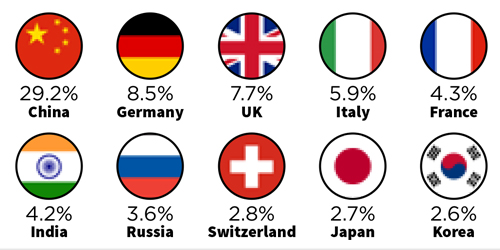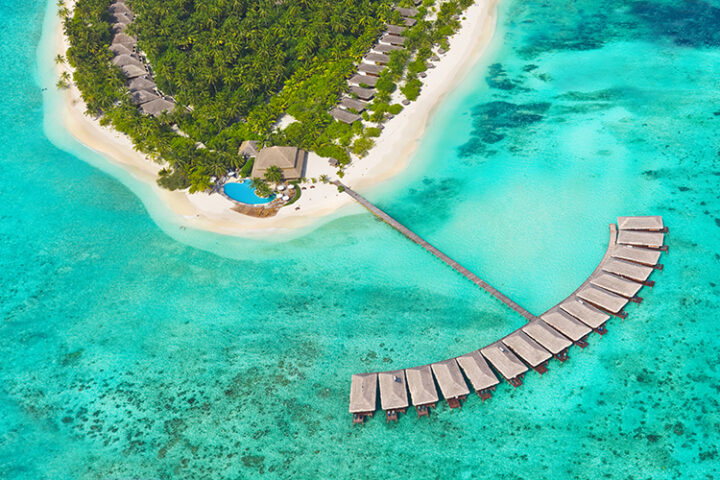
Tourism Indicators: The Changing Traveler Behavior
[vc_row full_width=”” parallax=”” parallax_image=”” bg_type=”” parallax_style=”” bg_image_new=”” layer_image=”” bg_image_repeat=”” bg_image_size=”” bg_cstm_size=”” bg_img_attach=”” parallax_sense=”” bg_image_posiiton=”” animation_direction=”” animation_repeat=”” video_url=”” video_url_2=”” u_video_url=”” video_opts=”” video_poster=”” u_start_time=”” u_stop_time=”” viewport_vdo=”” enable_controls=”” bg_override=”” disable_on_mobile_img_parallax=”” parallax_content=”” parallax_content_sense=”” fadeout_row=”” fadeout_start_effect=”” enable_overlay=”” overlay_color=”” overlay_pattern=”” overlay_pattern_opacity=”” overlay_pattern_size=”” overlay_pattern_attachment=”” multi_color_overlay=”” multi_color_overlay_opacity=”” seperator_enable=”” seperator_type=”” seperator_position=”” seperator_shape_size=”” seperator_svg_height=”” seperator_shape_background=”” seperator_shape_border=”” seperator_shape_border_color=”” seperator_shape_border_width=”” icon_type=”” icon=”” icon_size=”” icon_color=”” icon_style=”” icon_color_bg=”” icon_border_style=”” icon_color_border=”” icon_border_size=”” icon_border_radius=”” icon_border_spacing=”” icon_img=”” img_width=”” ult_hide_row=”” ult_hide_row_large_screen=”” ult_hide_row_desktop=”” ult_hide_row_tablet=”” ult_hide_row_tablet_small=”” ult_hide_row_mobile=”” ult_hide_row_mobile_large=””][vc_column width=”1/1″][vc_single_image image=”8063″ border_color=”grey” img_link_large=”” img_link_target=”_self” img_size=”full”][vc_empty_space height=”12″][vc_separator color=”grey” align=”align_center” style=”” border_width=”” el_width=””][vc_empty_space height=”12″][vc_column_text]Sahla Zahir
Since the introduction of tourism in the Maldives in 1972, the industry has shown tremendous growth in terms of tourist arrival, popularity of the destination and the excellent services provided by the tourism supply side. The sector now has become a major player in the nation’s economy and the number one contributor to the Gross Domestic Product (GDP). Considering the current performance, over one million tourists visited Maldives annually for the past two consecutive years while the arrival number for the first half of the year 2015 stood at 609,105 with an average growth rate of 1.26%.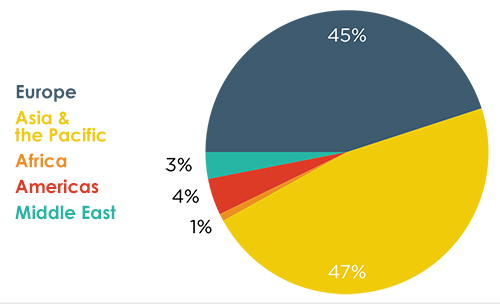
The major source markets
With the continued growth in number of inbound tourists from China and other Asian countries, the Asia Pacific region has become the number one region in terms of market share overtaking Europe- the previous market leaders. Moreover, China by far holds the highest market share as a single country with 29.2% while the market shares held by other key source markets range from 8% to 2%.
As the global and national tourism sector has been evolving with emergence of new source markets and shifts in geographical market segments, it is not just the only phenomenon the sector is experiencing. The whole traveller profile has been changing, with obvious differentiations on tourist demographics, behavioural patterns and psychographics as well. The Maldives Visitor Survey carried out in February 2015 by the Ministry of Tourism Maldives, revealed useful insights on what is driving tourists’ decisions for vacationing in the Maldives, what attracts and motivates them, their preferences, attitudes and values.
The demographic profile
According to the survey, the majority of current tourists visiting Maldives are young, unlike earlier days. A total of 34% of survey respondents fall between 25-34 years of age and about 67% aged 44 years or below. The survey also revealed that a higher percentage of younger tourists belong to newly emerging source markets such as China, India, Russia and Japan, while most tourists from the European region tend to be older.
The behavioural aspect
Looking into the behavioural patterns of inbound tourists as per the survey results, the behaviour at pre-purchase stage where information search and booking method for tourists from different geographic regions shows significant differences. Internet and Word of mouth are the most important sources of information among tourists now and the majority of tourists from the emerging markets use these sources while tourists from European region prefers to seek information from travel agents and conventional media such as TV, magazines, etc. Furthermore, one out of three tourists use TripAdvisor website to plan their trip to Maldives. The ‘Visit Maldives’ website managed by Maldives Marketing & Public Relations Corporation (MMPRC) has also been gaining popularity as based on the survey, one out of ten visitors refer to this website prior to their trip.
This increase in usage of internet among tourists has led to the increasing number of online vacation bookings by tourists especially from the emerging source markets. Booking.com- the most popular online travel agency has been the most common website used to book holidays, while cTrip, Expedia and Agoda and other online agencies as well as direct booking via resort or hotel website are also being used by tourists.
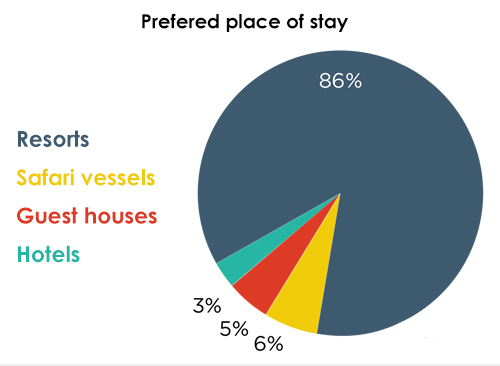 The survey further revealed that the most preferred accommodation facility by tourists visiting Maldives are resorts as 85% of respondents said they stayed in resorts. Also, among the visitors, 37% opt for all inclusive meal plans, while 23% chose full board and 18% went for half board during their trip in the Maldives. Moreover, about 88% of the visitors are accompanied by their partner or family implying that their partner or family has a significant role in the tourists’ decision to visit Maldives.
The survey further revealed that the most preferred accommodation facility by tourists visiting Maldives are resorts as 85% of respondents said they stayed in resorts. Also, among the visitors, 37% opt for all inclusive meal plans, while 23% chose full board and 18% went for half board during their trip in the Maldives. Moreover, about 88% of the visitors are accompanied by their partner or family implying that their partner or family has a significant role in the tourists’ decision to visit Maldives.
Despite the increased number of tourist arrivals the average duration of stay has been shorter and the length of stay of most of the visitors is 4-7 nights. The survey also revealed that the tourists from Asia and the Pacific region specifically from China, India and Japan tend to stay for shorter periods than their European counterparts. This shorter duration of stay by the new source markets has set an overall decreasing trend in the length of stay during the past couple of years. Yet, one third of the visitors are repeat visitors most of whom belong to the European region. This implies that visitor loyalty is higher among tourists from these source markets than visitors from the emerging markets.
Significant differences are also identified in the spending patterns and total expenditure among tourists from different nationalities. Tourists from emerging economies like Russia and China tend to spend higher on tourism than tourist from other nationalities. The survey showed that 26% of Russian and 17% of 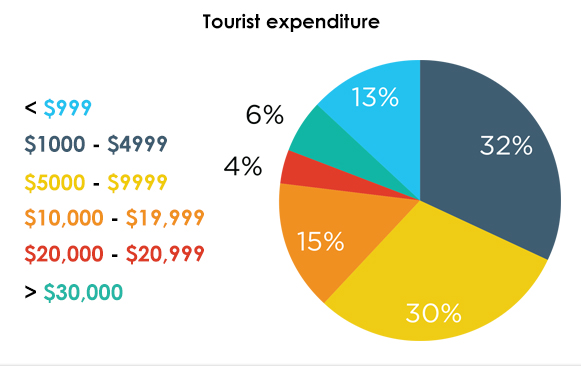 Chinese visitors spent more than US$ 30,000 on holiday. Though emerging economies show an increasing demand and a higher expenditure on tourism, the overall tourist expenditure has been rising.
Chinese visitors spent more than US$ 30,000 on holiday. Though emerging economies show an increasing demand and a higher expenditure on tourism, the overall tourist expenditure has been rising.
Examining the favourite activities of inbound international tourist, the survey affirmed that snorkelling and diving are the most popular activities among tourists with more than 90% of survey respondents rating these activities as ‘excellent’ or ‘very good’. Other popular activities include spa, sightseeing and surfing, while shopping was the poorest rated activity.
The Visitor Psychographics
Exploring the psychographic attributes that influences the travel behavior, the natural beauty of the Maldives is the most compelling factor that motivated inbound international tourists to visit Maldives regardless of which geographical region they belong. Other motivators for choosing Maldives include the country’s underwater beauty, peacefulness, small islands, uniqueness, weather, privacy, etc. Also, majority of tourists visit Maldives for rest and relaxation, while tourist often visit for honeymoon, snorkeling and diving.
Considering the post-purchase behavior and visitor experience, overall visitor satisfaction seems to be high and Maldives will continue to be a popular holiday destination. Among the survey participants, 94% said that their expectations are met, while 91% has the intention to visit again and 98% responded that they would recommend the Maldives to others.[/vc_column_text][vc_empty_space height=”12″][vc_separator color=”grey” align=”align_center” style=”” border_width=”” el_width=””][vc_column_text]Such knowledge and insight regarding visitor travel behavior can have huge implications on how the tourism products are targeted and positioned. As tourism is a complex, multi-layered product that involves the tourist in every process of production, knowledge and insight into tourists’ decision making, motivation, attitudes, interests and values are of utmost importance for providing an excellent service. Tourism businesses and policy makers alike should consider these changes in designing more focused tourism products, services and marketing communication strategies.[/vc_column_text][vc_empty_space height=”12″][/vc_column][/vc_row]




